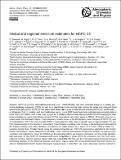| dc.contributor.author | Saikawa, Eri | |
| dc.contributor.author | Rigby, Matthew | |
| dc.contributor.author | Prinn, Ronald G. | |
| dc.date.accessioned | 2013-03-20T15:51:14Z | |
| dc.date.available | 2013-03-20T15:51:14Z | |
| dc.date.issued | 2012-11 | |
| dc.date.submitted | 2012-10 | |
| dc.identifier.issn | 1680-7324 | |
| dc.identifier.issn | 1680-7316 | |
| dc.identifier.uri | http://hdl.handle.net/1721.1/77951 | |
| dc.description.abstract | HCFC-22 (CHClF[subscript 2], chlorodifluoromethane) is an ozone-depleting substance (ODS) as well as a significant greenhouse gas (GHG). HCFC-22 has been used widely as a refrigerant fluid in cooling and air-conditioning equipment since the 1960s, and it has also served as a traditional substitute for some chlorofluorocarbons (CFCs) controlled under the Montreal Protocol. A low frequency record on tropospheric HCFC-22 since the late 1970s is available from measurements of the Southern Hemisphere Cape Grim Air Archive (CGAA) and a few Northern Hemisphere air samples (mostly from Trinidad Head) using the Advanced Global Atmospheric Gases Experiment (AGAGE) instrumentation and calibrations. Since the 1990s high-frequency, high-precision, in situ HCFC-22 measurements have been collected at these AGAGE stations. Since 1992, the Global Monitoring Division of the National Oceanic and Atmospheric Administration/Earth System Research Laboratory (NOAA/ESRL) has also collected flasks on a weekly basis from remote sites across the globe and analyzed them for a suite of halocarbons including HCFC-22. Additionally, since 2006 flasks have been collected approximately daily at a number of tower sites across the US and analyzed for halocarbons and other gases at NOAA. All results show an increase in the atmospheric mole fractions of HCFC-22, and recent data show a growth rate of approximately 4% per year, resulting in an increase in the background atmospheric mole fraction by a factor of 1.7 from 1995 to 2009. Using data on HCFC-22 consumption submitted to the United Nations Environment Programme (UNEP), as well as existing bottom-up emission estimates, we first create globally-gridded a priori HCFC-22 emissions over the 15 yr since 1995. We then use the three-dimensional chemical transport model, Model for Ozone and Related Chemical Tracers version 4 (MOZART v4), and a Bayesian inverse method to estimate global as well as regional annual emissions. Our inversion indicates that the global HCFC-22 emissions have an increasing trend between 1995 and 2009. We further find a surge in HCFC-22 emissions between 2005 and 2009 from developing countries in Asia – the largest emitting region including China and India. Globally, substantial emissions continue despite production and consumption being phased out in developed countries currently. | en_US |
| dc.description.sponsorship | NASA Upper Atmospheric Research Program (Grant NNX11AF17G) | en_US |
| dc.language.iso | en_US | |
| dc.publisher | Copernicus GmbH | en_US |
| dc.relation.isversionof | http://dx.doi.org/10.5194/acp-12-10033-2012 | en_US |
| dc.rights | Creative Commons Attribution 3.0 | en_US |
| dc.rights.uri | http://creativecommons.org/licenses/by/3.0/ | en_US |
| dc.source | Copernicus | en_US |
| dc.title | Global and regional emission estimates for HCFC-22 | en_US |
| dc.type | Article | en_US |
| dc.identifier.citation | Saikawa, E. et al. “Global and Regional Emission Estimates for HCFC-22.” Atmospheric Chemistry and Physics 12.21 (2012): 10033–10050. | en_US |
| dc.contributor.department | Massachusetts Institute of Technology. Center for Global Change Science | en_US |
| dc.contributor.mitauthor | Saikawa, Eri | |
| dc.contributor.mitauthor | Rigby, Matthew | |
| dc.contributor.mitauthor | Prinn, Ronald G. | |
| dc.relation.journal | Atmospheric Chemistry and Physics | en_US |
| dc.eprint.version | Final published version | en_US |
| dc.type.uri | http://purl.org/eprint/type/JournalArticle | en_US |
| eprint.status | http://purl.org/eprint/status/PeerReviewed | en_US |
| dspace.orderedauthors | Saikawa, E.; Rigby, M.; Prinn, R. G.; Montzka, S. A.; Miller, B. R.; Kuijpers, L. J. M.; Fraser, P. J. B.; Vollmer, M. K.; Saito, T.; Yokouchi, Y.; Harth, C. M.; Mühle, J.; Weiss, R. F.; Salameh, P. K.; Kim, J.; Li, S.; Park, S.; Kim, K.-R.; Young, D.; O'Doherty, S.; Simmonds, P. G.; McCulloch, A.; Krummel, P. B.; Steele, L. P.; Lunder, C.; Hermansen, O.; Maione, M.; Arduini, J.; Yao, B.; Zhou, L. X.; Wang, H. J.; Elkins, J. W.; Hall, B. | en |
| dc.identifier.orcid | https://orcid.org/0000-0001-5925-3801 | |
| dc.identifier.orcid | https://orcid.org/0000-0003-2233-8945 | |
| mit.license | PUBLISHER_CC | en_US |
| mit.metadata.status | Complete | |
